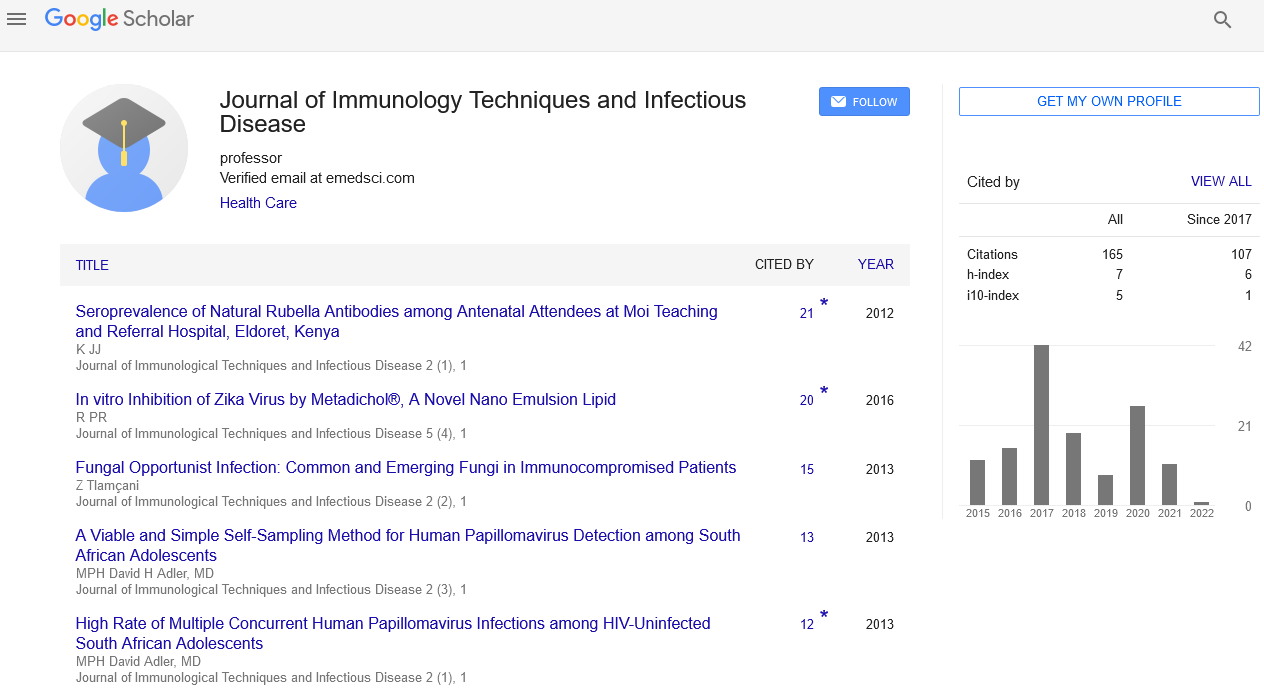Perspective, J Immunol Tech Infect Dis Vol: 12 Issue: 3
Stages of Vaccine Development: Manufacturing and Quality Control
Yae Natalia*
1Department of Paediatrics, The University of Melbourne, Parkville, Australia
*Corresponding Author: Yae Natalia,
Department of Paediatrics, The University
of Melbourne, Parkville, Australia
E-mail: yae1nat.lia@gmail.com
Received date: 30 August, 2023, Manuscript No. JIDIT-23-116450;
Editor assigned date: 01 September, 2023, PreQC No. JIDIT-23-116450 (PQ);
Reviewed date: 15 September, 2023, QC No. JIDIT-23-116450;
Revised date: 22 September, 2023, Manuscript No. JIDIT-23-116450 (R);
Published date: 29 September, 2023, DOI: 10.4172/2329-9541.1000354.
Citation: Natalia Y (2023) Stages of Vaccine Development: Manufacturing and Quality Control. J Immunol Tech Infect Dis 12:3.
Description
Vaccines have been instrumental in preventing and controlling infectious diseases for centuries, saving countless lives and improving public health worldwide. The development of a vaccine is a complex and meticulously structured process, involving multiple stages to ensure safety, efficacy, and regulatory approval. The journey to creating a new vaccine begins with the identification of a pathogen or disease target. This often involves extensive research to understand the microorganism's structure, genetics, and the immune response it triggers in the human body.
Investigational New Drug (IND) application
Before a vaccine can be tested in humans, developers must submit an investigational new drug application to the relevant regulatory authorities, such as the U.S. Food and Drug Administration (FDA) in the United States. This application includes detailed data from preclinical studies, outlining the vaccine's safety profile and proposed human trials.
Phase I: In this initial phase, a small group of healthy volunteers (usually less than 100) receives the experimental vaccine. The primary goal is to assess the vaccine's safety and dosage, as well as its ability to generate an immune response.
Phase II: In this phase, the vaccine is administered to a larger group (typically several hundred) to further evaluate its safety and immunogenicity. Researchers also begin to collect data on the vaccine's effectiveness in preventing the disease.
Phase III: This is the pivotal phase of clinical trials, involving thousands to tens of thousands of participants. Researchers assess the vaccine's efficacy in preventing the disease on a larger scale. Phase III trials also help identify less common side effects that may not have been detected in smaller groups.
Manufacturing and quality control
Once regulatory approval is granted, the vaccine can enter the manufacturing phase. This stage involves large-scale production of the vaccine, ensuring consistency, purity, and quality control. Manufacturing facilities must adhere to Good Manufacturing Practices (GMP) to meet regulatory standards. Vaccine developers work closely with manufacturers to produce sufficient quantities for distribution. Many vaccines are grown in cell cultures, where the target antigens are produced. This step is essential for ensuring a steady supply of antigens for vaccine production. Vaccines are formulated with various ingredients, including adjuvants to enhance the immune response, stabilizers to maintain vaccine integrity, and preservatives to prevent contamination. The vaccine is filled into vials or syringes, carefully labeled, and packaged for distribution.
Even after a vaccine is approved and distributed, its safety and effectiveness are continuously monitored through post-marketing surveillance. This phase involves ongoing data collection on vaccine outcomes, side effects, and adverse events. Vaccine developers, regulatory agencies, and healthcare professionals collaborate to track the vaccine's performance in real-world conditions. If safety concerns or unexpected side effects arise, regulatory agencies may take action, including issuing warnings or recommendations for vaccine use. Once a vaccine receives regulatory approval, it is distributed to healthcare facilities, clinics, and vaccination centers. The distribution process must be carefully coordinated to ensure that vaccines reach their intended recipients while maintaining proper storage conditions.
Conclusion
The development of a vaccine is a lengthy and rigorous process that requires particular research, rigorous testing, and strict regulatory oversight. Each stage plays an important role in ensuring that vaccines are safe, effective, and capable of protecting individuals and communities from infectious diseases. The successful development, approval, and distribution of vaccines have been pivotal in preventing and controlling a wide range of diseases, from polio and measles to COVID-19. Healthcare professionals administer vaccines following established vaccination schedules and guidelines. The goal is to provide immunity to as many individuals as possible to control the spread of the targeted disease.
 Spanish
Spanish  Chinese
Chinese  Russian
Russian  German
German  French
French  Japanese
Japanese  Portuguese
Portuguese  Hindi
Hindi 
